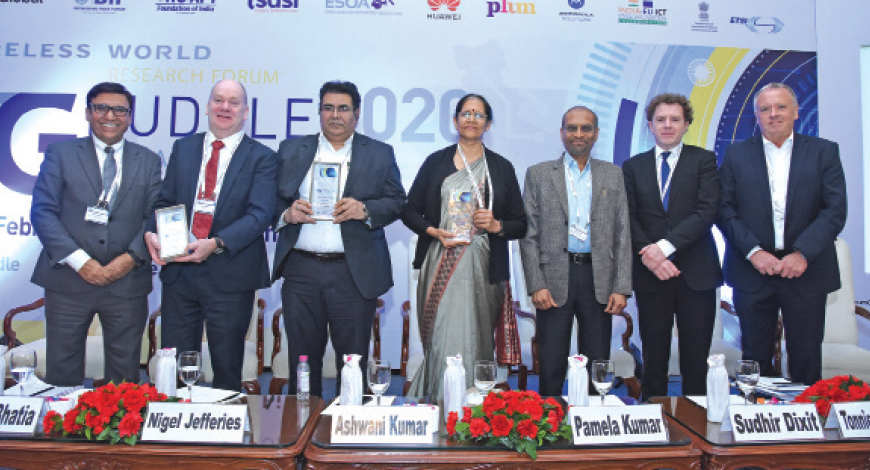Events
5G – A catalyst for digital transformation

The 7th 5G Huddle was held in New Delhi on February 5 and 6, 2020, at Hotel Imperial, New Delhi. The theme was 5G as a catalyst for digital transformation. It was organized by the Wireless World Research Forum (WWRF) in partnership with Broadband India Forum (BIF), the ITU-APT Foundation of India, and the Telecommunications Standards Development Society, India (TSDSI). Since its inception in 2014, the annual 5G Huddle has brought key 5G stakeholders together in various locations across the globe, including the United Kingdom, Europe, Canada, South Africa, and Japan. The event was attended by over 200 delegates from all over the world.
Excerpts from some presentations
“The ITU has set goals for IMT-2020, such as 100 times higher system capacity, etc. We are nearly at the final stage to define 5G. So far, 34 countries have already launched 5G. It will also support a large number of use cases.”
Bharat Bhatia, President, ITU-APT Foundation of India “Cybersecurity challenges in 5G networks are there. In the UK, they came out with guidelines for consumer IoT. There will be a big jump in IoT devices with 5G. There may not be retrofitting of the IoT devices, which can be a challenge. We need to classify IoT devices and have the minimum security requirements in place. With 5G, there will be some disaggregation in applications. Is the security level mature for these? The general security aspects are quite common worldwide.”Narendra Nath, Joint Secretary, NIC, GoI“5G may open up whole, new opportunities. However, there are certain doubts regarding 5G. There are a lot of new capabilities in latency, throughput, etc., that have been added. But, are we using 4G fully? There may be frugal 5G deployments. What is in 5G that will alter our living styles? From the policy perspective, there may be attractive pricing for building backhaul. What are the rights of way that need to be addressed? 5G will bring a new era in the service-delivery mechanism. It needs to be revenue churning for the operator as well.”Kishore Babu, Deputy DG, Department of Telecommunications.
“This year’s 5G Huddle will critically review what is happening in 5G globally as well as look at the future. The Huddle will also present case studies of 5G for rural and urban environments. WWRF has been at the forefront of wireless research since 2001, and we have a long engagement with India.”Nigel Jefferies, Chairman, Wireless World Research Forum
Henrik Berndt, Vice Chair for Europe, Middle East, Africa, Wireless World Research Forum
“We now have an ability from the government side to be involved in the technical side. When we look at 5G, we are looking at the out-coming spectrum auction. There are two things – price and quantum, for the operators. With 175MHz of spectrum left over, there was not much to do. Besides pricing, we now have a quantum issue to deal with. The Philippines is giving away spectrum for free to its operators. Can India learn from this? Who is going to put up their hands regarding the utilization of the spectrum? These are the matters that need to be resolved.”Rajan Mathews, DG, Cellular Operators Association of India
“5G has to be helpful to businesses. 3G and 4G were helpful in the growth of the wireless industry. We made a number of recommendations to the EC. We have focused on large infrastructure requirements. At the Commission level, there was a push for healthcare. We recently completed a study of ports. There were about 120 base stations installed at a port. We need to get emerging business models, stick with them, and make them sustainable.”Simon Fletcher, CTO, Real Wireless“Many of the security areas have been addressed in 5G. Network slicing is set to be the biggest benefit for apps. We can take appropriate measures.”Debabrata Nayak, Chief Security Officer, Huawei“The march of technology and digital consumption has been massive. 5G will also transform the way businesses are conducted. There will be enhanced mobile broadband, mission-critical communications, and massive IoT, such as connected cars, remote surgery, etc. 5G use cases will span across many industry verticals. There is a need to create a sustainable investment climate. Network slicing will be needed for critical, priority communications. There are cybersecurity challenges as well, so there is a need to improve standards, technologies, identify risks, etc. We need to protect the network infrastructure and devices, consumers, and multi-stakeholders.”P Balaji, Chief Regulatory and Corporate Affairs Officer, Vodafone Idea“3GPP continues to expand the LTE platform to improve its efficiency to meet the mobile broadband demand. Phase 2 (Rel 16) completes the IMT-2020 submission and addresses the identified use cases and requirements. 5G has already been launched in many countries, including USA and China. These are exclusively in the non-standalone mode. They are delivering mobile broadband. The operators are taking a low-risk approach to 5G, perhaps. The question that arises is: when will the standalone mode be deployed? When will services, other than the mobile broadband, be delivered? Rel 15 NR is delivered to meet the market needs. Rel 16 involves huge work from the 5G community. Rel 17 is IoT driven. There will be more 5G support for verticals. There are new enhancements for the radio and the system in Rel 17. The overall RAN timeline for Rel 17 has a 15-month gap. We have only launched 5G NR (new radio). Standardization is a long way ahead of deployment. There is a major push to add more use cases and accelerate releases, which are driven by the demand side. A corresponding response is needed from the supply side. Scale will be essential to close the gap.”Adrian Scrase, CTO, ETSI















You must be logged in to post a comment Login